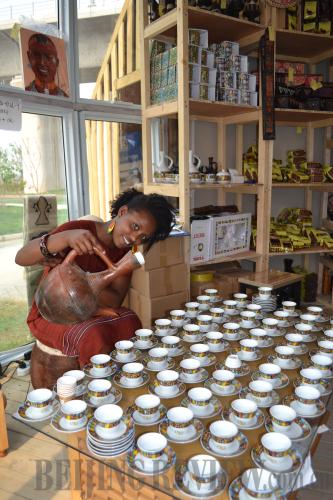|
 |
|
COFFEE TIME: Visitors can sample Ethiopian coffee when they visit the Ethiopian Pavilion of the Beijing Garden Expo (LIU JIAN) |
The Beijing Garden Expo is flourishing, attracting between 30,000 and 40,000 visitors a day, translating into 3 million yuan ($489,300) to 4 million yuan ($652,400) in entrance fees every day. While most of these attendees are drawn to the large gardens representing various Chinese cities and provinces, one corner of the expo offers savvy visitors a chance to see some more international sights. With pavilions from European, South American, Asian and African countries, the Expo's International Exhibition Park, located between the Expo's first and second gates, adds some multicultural variety to the expo.
Unfortunately, the complimentary buses that run between the garden expo gates and the nearest subway stop (Garden Expo Park on Line 14) shuttle visitors away from this area. As a result, the number of expo attendees visiting the International Exhibition Park has remained low. Magdi Shanouda, who runs the Sudanese Pavilion, is troubled by the low levels of foot traffic, "They say there are over 30,000 visitors a day, but I haven't even seen 5,000 people pass by here today."
One possible solution suggested by the staff of both the Ethiopian and Cameroonian pavilions, which are also struggling to drum up more business, is an increase in advertising and more support from expo management. At present, expo maps do not list or identify separate pavilions in the International Exhibition Park, and visitors have no way to find specific pavilions without simply exploring on their own. The expo's shuttles also have no direct access to the International Exhibition Park. Currently, shuttle drivers can only bring visitors to the edge of the area, out of sight of any of the pavilions.
Slow sales are a serious problem for the entrepreneurs and managers running these pavilions. Positive experiences and strong sales at similar events, such as the Shanghai World Expo, encouraged the businesses funding these pavilions to invest tens of thousands of U.S. dollars into the construction of the pavilions, which must now be recouped through sales profits.
Slow sales due to a low level of exposure to potential customers is not the only problem plaguing these pavilions. Mohamed Elmorshdy, manager of the Egyptian Pavilion, has displays of clothing, jewelry, statuettes, and Egyptian art in his country's pavilion. But the majority of his merchandise and pavilion decorations are still being processed by customs, further limiting sales at his pavilion. He fears that it may take months to get access to his goods, and that customs fees will end up adding significantly to his business expenses.
The Ethiopian Pavilion, funded and run by Ruian Best, an international trading company with offices in Hangzhou of Zhejiang Province, is also waiting for some merchandise to pass through customs, but is already well stocked with jewelry, art, handcrafted items, Ethiopian coffee and coffee cups and pots. Visitors to the pavilion can even sample Ethiopian coffee at the pavilion, where the staff brew and serve it according to Ethiopian traditions. Despite this extra attraction, business at the pavilion has been slow during the work week, with sales picking up slightly on weekends.
Ide Nkameni, who manages the Cameroonian Pavilion, is facing similar difficulties. Her pavilion is filled with clothing, jewelry, traditional masks, carvings, and other handicrafts. But she is struggling to get visas for employees from Cameroon who she hired to help introduce Cameroonian culture and explain the cultural significance of her merchandise to expo visitors.
Despite the logistical and bureaucratic difficulties plaguing her Pavilion, Nkameni, who ran a similar operation at the Shanghai World Expo and has years of experience doing business in China, is confident that business will pick up as the expo continues and access to the International Exhibition Park is made easier.
Other African pavilion managers expressed similar optimism. Their past experiences working at other international expos in China set a high bar for the Beijing Garden Expo. But the African pavilions' staff are confident that as the Expo continues, and as its management finds time to address their concerns, their investments will begin paying off.
Email us at: liuyunyun@bjreview.com |
